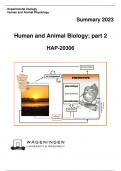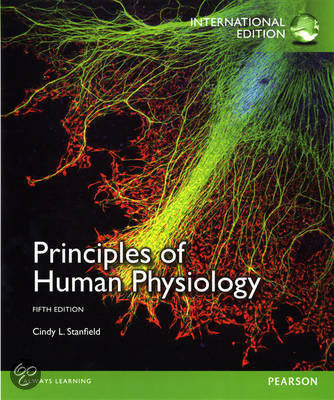Experimental Zoology
Human and Animal Physiology
Summary 2023
Human and Animal Biology; part 2
HAP-20306
,HAP Planning content 2023 (71h)
Disclaimer: times are based on how long it was scheduled on campus, looking at the material for the first time will
take around the same hours, studying the summary itself will take less. This is a thorough summary, including
lectures and practicals and highlights for the exam
Yellow: interim exam 1, Green interim exam 2, Pink interim exam 3, Blue interim exam 4, Grey no interim exam
L = lecture (13x: L14-26))
Pph = physiological practical (4x: pph3,4,7,8)
Ph = histological practical (2x: Ph4,5)
Pz = zoology practical (4x: Pz7,8,9,10)
QUIZLET
KAHOOT (SANDER)
Find Latin word origin for when knowing vessels etc.: google: (word) + etymology
Search in the document (CTRL+F) for EXAMQ for things that could be asked on exam.
YELLOW = Theme 2.5: energy, digestion, pig
GREEN = Theme 2.5/2.6: Skull, GI histology, heart & system
PINK = Theme 2.6/2.7/2.8: heart sheep, respiratory system, lungs sheep, osmoregulation, acid-base balance kidneys
BLUE = Theme 2.7/2.8/3: histology lungs, respiration practical, practical acid-base kidney, evolution, taxonomy:
phenetics and cladistics
GREY = Theme 3: phylogeny division, taxonomy biodiversity chordates and vertebrates
EXAM A
Theme 2.5: Organisms: digestive system and energy metabolism (22) EXAM A
L14: Energy metabolism and thermoregulation Sander 30 aug (2h)
Kahoot quiz Energy Metabolism
https://create.kahoot.it/share/energy-metabolism/b9c9ad9f-9a08-4f19-acb8-5f5112ff7f1e
Answers
• Glucose oxidation is catabolic and produces energy
• How much ATP is generated per day during rest? 50kg
• Which of the following processes is most important during fasting: gluconeogenesis
• What can be used as a substrate for gluconeogenesis – lactate, amino acids, pyruvate
• Glycogen stores in muscle is NOT used to maintain blood glucose levels (EXAMQ)
• Anaerobic glycolysis produces lactate
• Which of the following is true during the absorptive phase – glycogenesis is increased
• The main substrate for the brain is glucose (EXAMQ)
• The following process take place (partly) in the mitochondria: gluconeogenesis, lipogenesis, Krebs cycle
(TCA)
Lecture notes
Energy metabolism is very important for our organs and for animals to survive. Energy is needed for normal
processes the body executes to survive.
Energy metabolism: all chemical reactions in the body which are involved in energy storage and usage.
Food <-> building blocks (e.g., fatty acids)
This process is energy metabolism
Catabolism: (hint: catapult), destructive metabolism. (ATP) (EXAMQ)
1. Breakdown
2. Energy producing
Anabolism: (up) constructive metabolism
3. Building
4. Energy storage
- Explain the generation (from macro-nutrients) & role of ATP in energy metabolism
ATP: Universal energy carrier
- Capture free energy by catabolism of macro nutrients
a. Aerobic (O2)
b. Anaerobic
, - Needed for labour/work or storage
Universal energy molecule used in your body = ATP with 3 phosphates
During different situations: aerobic and anaerobic
ATP is needed for labour work and storage
If you just sleep, you still use a lot of energy
For 24 hours when you only sleep, you use your body weight of mass of ATP
Short idea of glucose oxidation
It’s not 100% efficient (heat)
ATP is used for every type of energy requirement reactions (cellular movement etc.)
Metabolism of macronutrients
Uptake of carbohydrates
Glucose
- Uptake: glucose transporters (is this regulated? Both)
- Used for energy (glycolysis, Krebs, OXPHOS)
- Metabolized via other routes: glycerol, fatty acids, nucleotides
- Storage: glycogen (glycogenesis) (mainly muscle, liver, but also brain)
- Glycogen broken down to glucose (glycogenolysis)
Uptake of proteins
Amino acids
1. Uptake: specialized transporters
2. Storage: assembled to proteins (muscle)
3. Used: deamination NH3 (Krebs, OXPHOS)
4. Proteins degrade amino acids (proteolysis) if necessary
Note: proteins always have a functional role!
Uptake of fats
Triglycerides
1. Lipoproteins in blood broken down to free
fatty acids and monoglycerol (lipoprotein lipase)
2. Uptake: diffusion into cell
3. Used: fatty acids broken down into acetyl CoA
(beta-oxidation) and oxidized Krebs, OXPHOS
4. Storage: fatty acids and glycerol assembled
into triglycerides (lipogenesis)
5. Triglycerides broken down (lipolysis)
Metabolism of Macronutrients
Proteins <-proteolysis-> amino acids
Glycogen – glycogenolysis-> glucose -glycogenesis-> glycogen
Triglycerides – lipolysis-> glycerol + fatty acids -lipogenesis-> triglycerides
We talked about the different breakdowns of nutrients
Triglycerides (made= lipogenesis, broken down = lipolysis)
Gluconeogenesis
Glucose level needs to remain constant
Can be from amino acids that enters Krebs cycle or pyruvate
Important: Every substrate that produces acetyl coA, cannot produce glucose. Acetyl coA is used up.
, Substrates for glucose: (EXAMQ)
1. Amino acids - Not every amino acid can produce glucose - is
produced during sprinting for glucose
2. Lactate (Cori cycle)
3. Glycerol (not fatty acids!)
4. Products Krebs cycle
- Needs ATP
- Liver (also kidneys, not muscle) - Only the liver can produce
glucose that can be released into the bloodstream
- Active low blood glucose levels (why?)
Krebs cycle
Important: NASH/FADH2 is stored, it’s an electron carrier, use
electrons to produce energy
Glucose oxidation
Steps:
1. Glycolysis: a set of reactions take place. Energy is invested
and after this many reactions whereby energy is produced
can take place. To capture this energy ATP is produced or
NADH is produced. (EXAMQ)
2. Pyruvate -> acetyl-CoA (mitochondria) (EXAMQ)
3. Krebs cycle (TCA)
4. Electron transfer system
Stepwise energy loss (final acceptor is O2)
chemi-osmotic coupling
5. Chemi-osmotic coupling
ATP generated using H+ gradient
Maximal ATP production (glucose)
C6H12O6 + 6O2 + 32 ADP + 32 Pi -> 6 CO2 + 6 H2O + 32 ATP
4&5= Oxidative phosphorylation
1 glucose leads to 32 ATP
Majority is formed by electrons NAD and FAD (4&5)
Anaerobic situations (low oxygen)
No O2 available as an electron acceptor
1. No activity of Krebs cycle and OXPHOS
2. Accumulation of pyruvate and NADH -> Shutdown glycolysis
Anaerobic glucose oxidation
Pyruvate -> lactate: 2 ATP + 2 NAD+
(Cori cycle: liver converts lactate into glucose) But very inefficient ATP production
Efficiency ATP production
Pi = inorganic phosphate
Aerobic
C6H12O6 + 6O2 + 32 ADP + 32 Pi -> 6CO2 + 6H2O + 32 ATP
Released energy during glucose oxidation = 686 kcal
Energy storage of 1 ATP molecule = 7 kcal
- Efficiency ATP production = ? (Approximately 32,6%)






